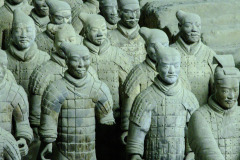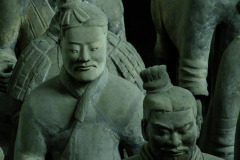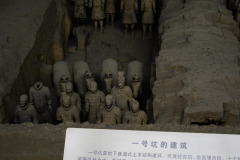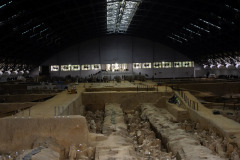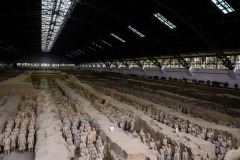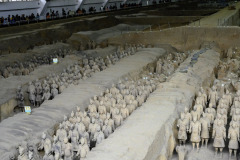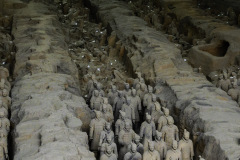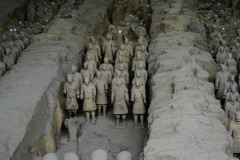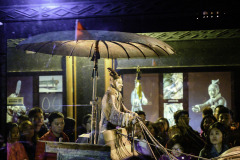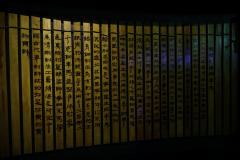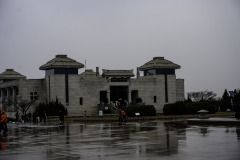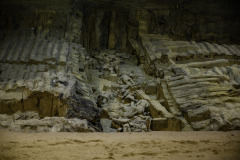The first thing on the agenda for the day was a trip to the city wall. Apparently it’s the last “active”, complete wall in China. Of course, nowadays it’s just for a point of interest.
Off to the one of the sides of the part of the wall that we visited was a place where the locals gathered for various communal activities, notably table tennis, exercise and playing instruments. Apparently when it was being built the residents took the bricks to build their homes. This meant that the original version of the wall ended up being made of mostly mud and wood. It was later improved with brick.
The Anding gate (the part that we visited) was based on the middle gate of the Tang Dynasty in the west, which was maintained in the New City constructed by Han Jian, the governor of Youguo Jun. It was moved a little southward in the expansion of the city walls between the 7th and 11th Hongwu year (1374-1378 AD) in the Ming Dynasty and named “Anding” implying that the nationalities in the west frontier would live together in harmony, safety and peace. In 1987, six brick arched gateways, three on each side of the gate, were opened for human and vehicle use. Today there exists the gate tower, the barbican, the arrow tower in the West Gate.
no images were found
The wooden screen (photo 1125) is an ancient mobile cart equipped with wooden planks to screen off arrows and stones in a siege. As is recorded in the 13th chapter of the military sections in the Comprehensive Institutions, a Chinese institutional history and encyclopedia, the wooden screen consists of a wooden plank that hangs on an ancient water-lifting device mounted on four-wheeled carts. Hiding behind the wooden screen, swift soldiers can protect themselves from arrows and stones while approaching and climbing the city wall. The wooden screen evolved into this shape (photographed) after continuous modifications. At earlier stages, grass, cloth, wood and animal skin were used as screens.
The stone-hurling vehicle is a man-powered weapon that uses level principle to fling stones at distant enemies. As one of the ancient combat vehicles, the stone-hurling vehicle came into use as early as the Spring and Autumn era (770BC – 476BC) and became major defence and offence weapons in sieges after the Sui and Tang dynasty (581AD – 907AD). The piece of pao in Chinese chess derives its name from the stone-hurling vehicle, which is also named pao vehicle or thunderbolt vehicle due to the thundering sound it made while hurling stones. The Collection of the Most Important Military Techniques, published in the Song dynasty (960AD – 1276AD), defines the stone-hurling vehicles as powerful military weapons indispensable to both the offensive and the defensive. The book described eight commonly-used hurling vehicles of the time, among which the biggest one measured 8.76m long with a hurling range of over 140m. It required 250 men to operate and could hurl 45Kg stone balls in one go.
Next on the list was a trip to a jade shop, where they process jade and jadeite and make them into various items. The rep showed us the differences between the different qualities of jade and jadeite that are available, which also included some different colours – the lower-quality, easily-obtainable jade would be used to make things like statues, while the jadeite is used for jewellery.
no images were found
The globes were made from jade as well but you couldn’t tell if you weren’t told – even tapping it, it sounded like plastic. They obviously had no interest in display pieces – if it was on a shelf or free-standing on the floor it was for sale. Even the shelves themselves would probably be for sale if you asked them. The chap also showed us a jadeite Buddha statue for sale, which must have been all of about a foot tall, very intricate, for about 3 million Yuan.
Unfortunately, one of the people that we were with suffered a substantial asthma attack on the way out from the shop, to the point where she couldn’t step outside without coughing uncontrollably. An ambulance had to pick her up and, thankfully, she was able to recover well enough to join us after lunch for the Terracotta Army. As a pre-warning we weren’t allowed to use a flash.
This was definitely one of those times when you’re more in awe of seeing it in person than the first time you hear about it. I was quite surprised to see a riot shield there so I took a quick snap.
Towards the back is the Convervation and Restoration Open Workshop, which was established in 2015 with sponsorship from Xian Janssen Pharmaceutical Ltd. It aims to show the actual process of restoring cultural relics and natural and human sciences involved, giving viewers the chance to take a closer look at the conservation and restoration process behind the glass barrier. Since 2000, Xian Janssen has collaborated with the Emperor Qin’s Museum of Terracotta Warriors and Horses to aid the preservation of this magnificent relic by providing the museum with research facilities, anti-fungal treatments, employee training and a first-class microbial laboratory for advanced material protection research in China.
Sally could talk for China! She really was bursting with historical knowledge. I wasn’t previously aware that the warriors were originally fully-coloured, having lost their colour when every single one was relieved of its (perfectly usable) weapon, smashed and buried many years ago then later essentially forgotten. It was only when someone that was trying to make themselves a well that the warriors were discovered then archaeologists started to piece them together again.
All the terracotta warriors in the pit held bronze weapons. The main ones are crossbows, arrows, arrow heads, spears, dagger-axes, halberds, Pí, Shū, swords, curved knives, etc.
We were provided with “free time” to walk around the first room then we met up to be shown where the meeting point was – a coffee shop again (I’m glad they did keep using coffee shops to meet up) – so that we could explore the second and third rooms (buildings). We wandered off to the third building, which was more of a display room than anything resembling the first building. The second building resembled the first but all of the warriors were still in pieces.
So, really, the first building had the main interest for me, along with an archer from the third building. The archers are the kneeling warriors, which are also the most recent find.
During the evening we were able to go for a walk around the town, which was a delightful sight where the buildings were lit up against the night sky but the hotel was too far away from the main, lit up area to walk. Sadly photos would have come out really poorly from the coach. Instead, we had a brief wander in the close vicinity to look around the shops then head back for an early night as we had a plane to catch in the morning.
